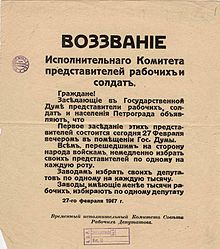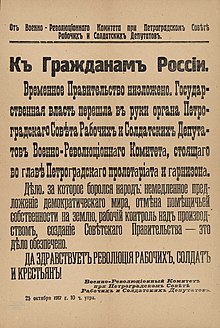Petrograd Soviet
The Petrograd Soviet of Workers 'and Soldiers' Deputies ( Russian: Петроградский Совет рабочих и солдатских депутатов ) represented the Petrograd workers and soldiers during the period of the Russian Revolution in 1917 . Founded during the February Revolution , it played a decisive role in the period up to the October Revolution as a legislative organ of dual power and a counterweight to the provisional government . After the victory of the October Revolution, he took over local government tasks in Petrograd.
Prehistory and foundation
During the Russian Revolution in 1905 , a Soviet was founded in the capital of Russia , which was then still called Saint Petersburg , to represent the Petersburg workers. The immediate forerunner of the Petrograd Soviet, however, was the Central Workers ' Group ( Центральная Рабочая Группа ) founded by the Mensheviks during the First World War in November 1915 , which mediated between the workers' interests and those of the central military-industrial committee belonging to the state power. The group became increasingly radicalized during the war and advocated revolutionary goals.

On January 27th, July / February 9, 1917 greg. The entire leadership of the Central Workers' Group was arrested by order of Interior Minister Alexander Protopopov and imprisoned in the Peter and Paul Fortress . On the morning of February 27th, Jul. / March 12th greg. they were liberated by revolutionary soldiers, and their chairman, Kuzma Gwosdew , called a meeting to elect a Soviet that same day. In the evening up to 250 people gathered in the Tauride Palace to elect a provisional executive committee (Ispolkom), which consisted of eight or nine people, exclusively Mensheviks, and which was headed by Nikolos Tschcheidze . The Izvestia newspaper was founded as a public announcement . Until August 1917, the seat of the Soviet was in the Tauride Palace, which was also the seat of the State Duma , and then in the Smolny Institute .
The next day the constituent meeting of the Soviet took place, at which the previously elected representatives of the factories and regiments took part. Most of the up to 3,000 members represented moderate parties and views, only around 10% could initially be attributed to radical parties such as the Bolsheviks , the social revolutionary maximalists or the Meschrajonzy . More than two thirds of the MPs were soldiers.
Under these circumstances, the Ispolkom played the dominant role; in March it comprised a group of around 20 people with a three-person presidium. Initially, members of the Presidium were Nikolos Tschcheidze, Matwei Skobelew and Alexander Kerensky . As a small circle of intellectuals, his claim to represent the interests of the common people was questionable from the start.
The Soviet during the "dual rule"
On March 1st, Jul. / March 14th greg. the Soviet issued its Order No. 1 to the Garrison of the Petrograd Military District. On the same day, the Ispolkom decided not to join the newly formed provisional government , thus establishing the so-called dual power . The Soviet reserved the right to review the decisions of the Provisional Government and in effect claimed legislative power in the state. A network of commissions arose, which together formed a kind of shadow cabinet . A contact committee has been set up for consultation with the government. The dual power system was confirmed by an eight-point program of the Lvov government approved by the Soviet .
According to the will of the Soviet, the council system should be extended to the whole country, for this purpose an all-Russian council assembly was called in Petrograd in the spring. Commissioners were sent to the fronts and fleets to ensure that the councils had a say in all important decisions. There was no farmers 'representation in the Soviets at that time, the Russian farmers, around 80% of the population, were organized in a separate farmers' union. The Petrograd Soviet was subsequently upgraded to an all-Russian decision-making body after newly formed councils in the provinces and on the fronts sent delegations to Petrograd. At the 1st All-Russian Congress of Soviets , which met in Petrograd in June 1917, an All-Russian Central Executive Committee was elected, and Cheidze took over as chairman. A rivalry developed between this body, still dominated by the moderate socialists, and the Petrograd Soviet, which intensified as the political majority in the latter shifted towards the Bolsheviks. As the Soviet of the revolutionary capital and due to personal continuities, its decisions continued to receive high attention and its importance as an opposition forum to the government continued to exist.
The Bolshevikization of the Soviet and the October Revolution
During the “April Crisis” triggered by the publication of the Miliukov Note , the contradiction between the Executive Committee's commitment to continuing the war in defense of the revolution and the annexationist goals of the bourgeois government emerged. The Bolsheviks returning from exile took advantage of these contradictions in order to gradually increase their previously poor representation in the Soviets.
After the resignation of the annexionist ministers Alexander Guchkov and Pavel Miliukov , the Petrograd Soviet declared itself ready to participate in the formation of a new government. As a result, several socialist ministers joined the new coalition government, and the previous Minister of Justice Kerensky took over the post of Minister of War and the Navy. Kerensky's vigorous advocacy of an offensive against the Central Powers in the summer of 1917 can be seen as one of the decisive reasons for the Bolsheviks' strengthening. The entry into government of the moderate socialists turned out to be a disadvantage for them, as they now shared responsibility for government decisions. The failure of the offensive and the resulting increasing weariness of the war led to a loss of confidence in the government, as did the opaque "Kornilov Affair" in August, which was interpreted as an attempt to establish a dictatorship. Although the Bolshevik Juliet uprising failed in Petrograd, the Bolshevik slogans such as “All power to the councils!” And “Down with the war!” Found increasing support here as elsewhere.
The increasing decline of the economy and the precarious food situation in the city also played into the hands of the Bolsheviks. The tendency to strike among the workers increased by leaps and bounds as the economic situation of the workers deteriorated more and more. The government's reluctance to convene a constituent assembly also met with criticism.
After the Kornilov revolt, the Bolsheviks used the majority they had won in the Petrograd Soviet together with the Left Social Revolutionaries , who usually voted with them , to urge the convening of a 2nd All-Russian Congress of Soviets . The slogan “All power to the councils”, initially rejected after the failed July uprising, was propagated again. On August 31, Jul. / September 13th greg. For the first time a Bolshevik resolution was passed by the plenary of the Soviet, whereupon the Menshevik-Social Revolutionary Presidium resigned. On September 25th Jul. / October 8th greg. was Leon Trotsky elected chairman of the Soviets, the Executive Committee was already halfway out the Bolsheviks. The threat to Petrograd from the German army after the capture of Riga on September 3 and the occupation of the Baltic Islands in the Albion operation was used by the Bolsheviks as an excuse to set up a Military Revolutionary Committee - ostensibly to organize the defense of the capital - which would be the control center of the armed forces Was uprising. The latter was on October 10th July. / 23 October greg. decided by the Bolshevik Central Committee.
On October 25th, Jul. / November 7th greg. Lenin said before a special session of the Soviet and declared the victory of the "workers and peasants revolution". In the course of the seizure of power, the Bolshevikization of the Soviet continued. After the elections on November 27th, July / December 10th greg. the central executive committee consisted of 34 Bolsheviks and 10 left-wing Social Revolutionaries, and Grigory Zinoviev was elected chairman. The latter headed the Soviet or the successor Lensoviet until he was ousted in 1926.
The Soviet during the Civil War years
After the October Revolution, the Soviet became the main body of local government in Petrograd. During the years of the civil war, he organized the supply of the city with food and raw materials, fought epidemics and ensured that production was maintained. From the spring of 1918, after the government moved to Moscow , the Soviet and other Soviets of northwestern Russia formed the "Union of Communes of the Northern Region" with its center in Petrograd, which was dissolved again in February 1919. In August 1920, it was decided to merge the Central Executive Committee of the City and that of the Provincial Soviet, while the Petrograd Soviet continued to lead the city administration.
In January 1924, the Soviet was in connection with the renaming of the city in Leningrad in Lensowjet renamed.
literature
- Richard Pipes : The Russian Revolution. 3 vols. Rowohlt , Berlin 1992–93.
Web links
- Petrograd Soviet of Workers 'and Soldiers' Deputies on the pages of the Saint Petersburg Encyclopedia (English / Russian)


